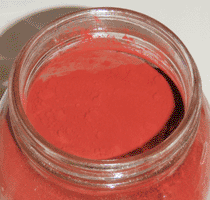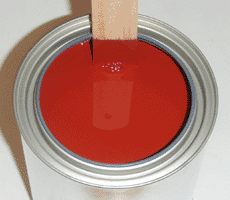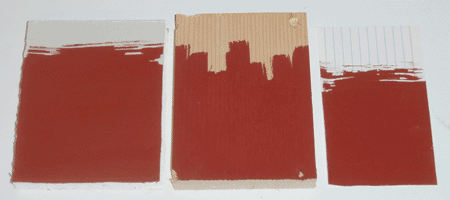


Paints are closely related to glues, since the binder or medium of a paint is essentially just a glue which holds the pigment together. As such, most glues can be made into paints, and casein is no exception. In its earliest form, casein paint was simply whitewash with milk added, in order to reduce its chalkiness for interior walls. Modern casein paint (often sold as "milk paint") is more refined, the binder being made from pure casein and lime; however, this introduces the drawback that it must be mixed just prior to use. Since my casein glue appears to be stable at room temperature, with no apparent tendency to harden or decompose, I decided to use it to make a paint that could be stored in a can.
The key ratio in any paint is that of the pigment to the binder, and this is largely dependent on the pigment being used. Since I wanted to make a red paint to match the tools in my workshop, I began with 10 grams of glue (containing one gram of casein), to which I added red iron oxide from Earth Pigments, one gram at a time. I brushed a small stroke of paint onto a glass slide for each increment, and by the fifth gram the dry paint had lost its gloss, and had no excess casein pooling around the edges. I then added water incrementally in the same manner, until the paint was thin enough to use with a large brush. Conveniently this required roughly 10 grams of water, for a final ratio of one part pigment to two parts glue and two parts water, by weight.
Although small quantites of paint can be prepared in this way if enough glue is available, for larger quantities I found it quicker to mix the paint from raw ingredients. By mixing the dry casein and pigment together, followed by the water to hydrate both, clumping can be avoided and the paint can be made homogeneous almost instantly when the ammonia is then added last. In this case, the ingredients are as follows, in parts by weight:
I prepared a quart of paint from 1kg of the above ingredients in their respective proportions, with each part being 40 grams for this particular batch. After briefly stirring the paint, waiting a day, then stirring again, it had become fully homogeneous with no casein skin or lumps of pigment remaining. As this type of paint is best suited to coating porous materials, I then tested it on pieces of drywall, wood, and cardstock, which can be seen at the top of the page. In all three cases the paint produced a flat (non-reflective) layer of color, with a few minor exceptions (patches of gloss) where the paint was applied too thickly and formed a puddle. The paint film is surprisingly durable, and I was unable to rub off any pigment by hand. Even more surprising is the flexibility of the paint on cardstock, neither cracking nor peeling when the paper was bent. Like the glue it is based on, the paint film also becomes insoluble over time; freshly dried paint will lose some pigment when wiped with a wet rag, but paint that has been dry for a few days will lose very little.
Due to its rapid drying and durability, this paint seems highly versatile, and in general appears to be a functional replacement for modern acrylic paint. For drywall and plaster, pigments can be heavily extended with chalk or other fillers to make large volumes of cheap wall paint. For wooden furniture, the paint film can be encapsulated in a subsequent oil-based finish, in order to improve its gloss and cleanability. Finally, its adhesion to paper makes it useful for posters, signs, and labels. There are likely many other potential uses, and as I encounter them I will record them here, along with any significant changes to the paint formula and mixing process.
The paint described above is highly concentrated and contains too little pigment relative to its binder. To extend its coverage and eliminate its tendency to form glossy patches, the following formula should be used:
In this case, each part will be 2.5% of the final mass of the paint. As usual, the pigment ratio depends on the attributes of the pigment being used, so this formula is likely only optimal for synthetic red iron oxide.
EDIT: 1/1/2021One major issue with this paint is its tendency for the pigment to settle to the bottom of the container. This can be solved in two ways: by thickening the paint, and by adding a suspension aid. The paint can be thickened by simply using less ammonia; at 5% of the weight of the casein (equal parts of casein and household ammonia), the paint becomes noticeably more viscous as the casein is only barely dissolved. Clay can then be used as a filler to replace some of the pigment (with kaolin being preferred for its lack of color) in order to stop the pigment from settling. Just as in a ceramic glaze, the irregular clay particles form a loose mesh which will not become compact over time, allowing the paint to be prepared later with only gentle stirring. The clay also makes the paint more slippery, which improves brushability.
One alternative method for making casein paint is to mull a dry pigment with borax-casein glue. This makes an interesting water-based substitute for oil paint, which has almost identical brushing qualities. Due to the stability of this type of glue, the paint can be stored in tubes, although it should likely be used within a year. In use, it occupies somewhat of a middle-ground between oil and watercolor painting, and shares some of the techniques of each.